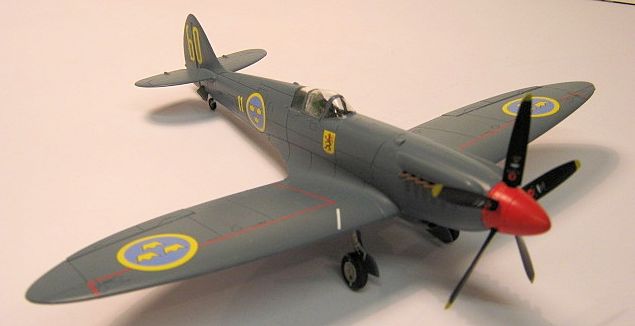
| KIT #: | A05119 |
| PRICE: |
£15-99 |
| DECALS: | Two options |
| REVIEWER: | Frank Reynolds |
| NOTES: |

| HISTORY |
Surely the
Grand Prix version of the Spitfire series, the PR.19 was fast, sleek and agile.
“Alone , Unarmed and Unafraid”, the pilots of the RAF’s photo reconnaissance
squadrons had the benefit of a proven airframe that was unburdened by the weight
and drag of cannons, ammunition and
armour. The Spitfire line had progressed from a Merlin-engined interceptor
fighter of 1936 to the uprated Griffon engine that
 first
appeared on the Mk12, then the Mk14. Derived from the Mk.14 fighter, the
dedicated Photo Recce PR.19 first went into squadron service in May 1944. It was
destined to be the last Spitfire version in front line service, finally retiring
in Singapore on April 1, 1954.
first
appeared on the Mk12, then the Mk14. Derived from the Mk.14 fighter, the
dedicated Photo Recce PR.19 first went into squadron service in May 1944. It was
destined to be the last Spitfire version in front line service, finally retiring
in Singapore on April 1, 1954.
Post war, in the early jet age, the Spitfire Pr.19 was still fast enough and high enough to be effective and compared with early jet aircraft had an impressively long range, all combining to ensure that it was still an effective asset. Sweden acquired 50 refurbished ex-RAF examples between October 1948 and May 1949 and these served with four squadrons until replaced in 1955. Sweden was unusual among Spitfire operators in that it only ever employed this specialist unarmed reconnaissance version. Being a neutral country in the crowded Cold War Baltic area, Sweden had need of effective intelligence gathering capability along its extensive land and sea borders. The Turkish and Indian Air Forces also took this thoroughbred into their inventories.
| THE KIT |
Neatly and
sharply moulded in pale grey flash-free softish plastic, this kit shows the
level of quality that Airfix is now consistently achieving. All of the parts
frames are new and unique to the PR version and there are options for extended
or retracted landing gear, open or closed canopy, separate control surfaces and
flaps and a choice of two decal finishes, both Cold War warriors, one from
Sweden and the other the last ever Spitfire in RAF front line service.
For those who
have toiled in the past converting fighter versions of Spitfire kits to this
specialised version, the troubles of the past are over since this sharp Airfix
offering features all of the essential characteristics of the PR version – the
unarmoured, rounded one-piece windscreen, the bulges in the under wing forward
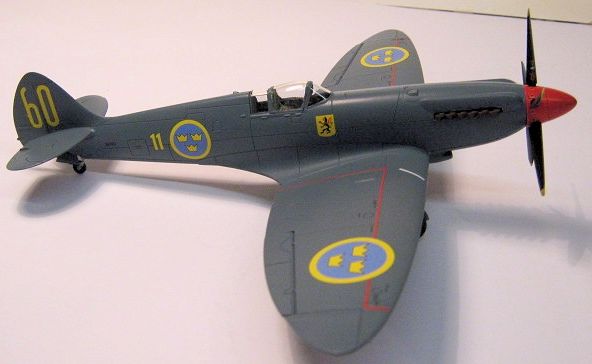 of the
wheel well for the fuel pump covers; the intake on the lower cowl side
under the exhausts for the cabin
pressurisation system; the smooth weapons-free wing structure and the camera
ports in the fuselage sides and belly.
of the
wheel well for the fuel pump covers; the intake on the lower cowl side
under the exhausts for the cabin
pressurisation system; the smooth weapons-free wing structure and the camera
ports in the fuselage sides and belly.
There are
some delightful touches in the kit. Perhaps to offset the lack of armament
options, the interior is enhanced with additional bulkheads and camera parts for
the rear fuselage and the option of opening up the camera hatches. A total of
five bulkheads offers scope for a very busy interior.
Three types
of wheel moulding are provided; half-wheels for the retracted gear option and
for the extended gear both full and flattened tyres, which are positively
located on to the axle stubs by a small key way. There are flat areas moulded
onto the inside face of the undercarriage legs to provide a positive seating for
the bay doors. The five bladed propeller is a one piece unit which aids blade
alignment.
Surface
detail is typical of the latest Airfix offerings, firmly defined might be one
way of putting it; some consider it too heavy handed, others are quite happy. I
find that it looks about right under a coat of paint, providing enough
definition without the need for any post-shading.
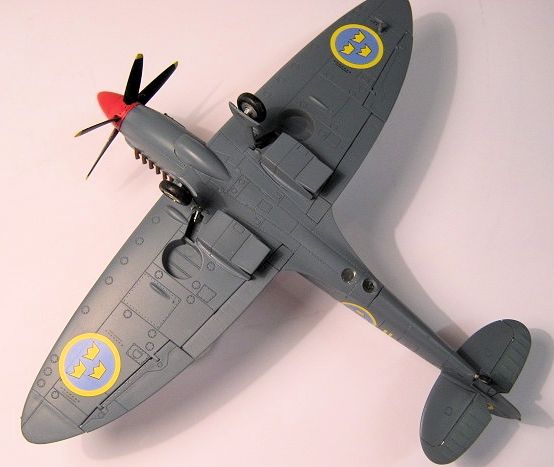 The clear
parts are effective, perhaps a trifle thick, but not a problem for my standards
of modelling. There is the option to model the canopy open, using a part first
introduced on Airfix’s Spitfire Mk.12 fighter, where the fixed rear section and
sliding centre section of the canopy are combined into a one-piece unit,
although this is very thick and requires some awkward masking inside and out and
a small section of the fuselage has to be cut away to accommodate it.
The clear
parts are effective, perhaps a trifle thick, but not a problem for my standards
of modelling. There is the option to model the canopy open, using a part first
introduced on Airfix’s Spitfire Mk.12 fighter, where the fixed rear section and
sliding centre section of the canopy are combined into a one-piece unit,
although this is very thick and requires some awkward masking inside and out and
a small section of the fuselage has to be cut away to accommodate it.
The decals
are crisp, clean, and of good colour density. Comprehensive stencilling is
provided for the Swedish version and examination under a magnifying glass shows
it to be seemingly written in Swedish – a neat touch. Mysteriously the RAF
version has little in the way of stencilling beyond the familiar “Trestle Here”
markings for the outer sections of the under wing. Further classy details
include tiny tyre creep marks for the wheels and a total of 15 tiny decals to
enhance the propeller and spinner assembly. Good eyesight and a steady hand are
useful here.
The RAF version has a two colour paint scheme with upper surfaces of Sea Grey medium and sides and under surfaces in PRU Blue; the Swedish version could hardly be simpler in overall PRU blue with a red spinner.
| CONSTRUCTION |
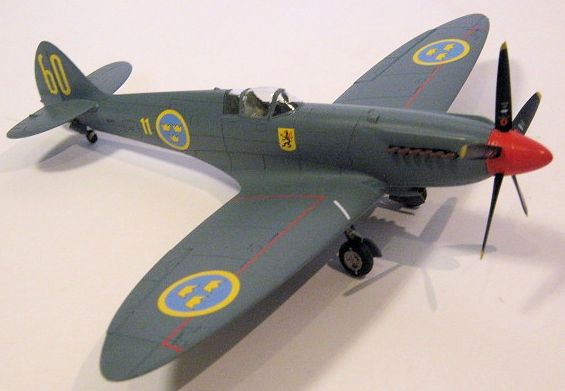 Construction
was simple straightforward and unspectacular. I followed the sequence in the
instructions, commencing with the interior. The level of detail and complexity
of the interior bulkheads and triple camera installation require the alignment
of the parts to be carefully checked before everything is closed up, but I found
no problems with this. No filler was needed and all of the parts locked neatly
into place, useful where alignment of wing dihedral and undercarriage legs is
concerned.
Construction
was simple straightforward and unspectacular. I followed the sequence in the
instructions, commencing with the interior. The level of detail and complexity
of the interior bulkheads and triple camera installation require the alignment
of the parts to be carefully checked before everything is closed up, but I found
no problems with this. No filler was needed and all of the parts locked neatly
into place, useful where alignment of wing dihedral and undercarriage legs is
concerned.
The only
aftermarket that I used was a set of Eduard PE seat belts.
There was no
fuss and no drama. If the build sequence is followed as per instructions a good
result can be expected for all but the most critical of modellers.
| COLORS & MARKINGS |
I chose the
Swedish version for the reasons given below, with the bonus of one of the
simplest colour schemes going, all in Hannants’ Xtracrylix paints applied with
my long serving Iwata HP-C airbrush
The decals
went on well over a coat of Future/Kleer and responded effectively to Micro Set
and Micro Sol.
| CONCLUSIONS |
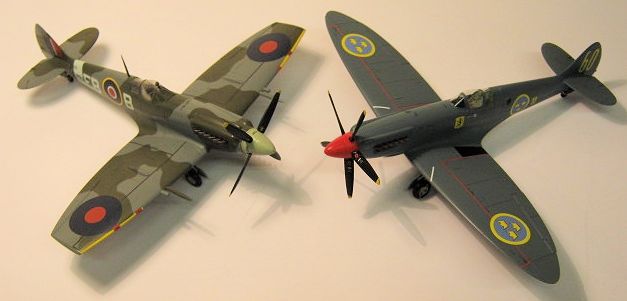
Compared with
the PR Mk.19, the 12 has:
| REFERENCES |
Spitfire
International by Helmut Terbeck, Harry van der Meer and Ray Sturtivant, Air
Britain (Historians) Ltd 2002.
Spitfire, the History by Eric B. Morgan and Edward Shacklady, Key Publishing, 2000
April 2013
Copyright ModelingMadness.com. All rights reserved. No reproduction in any form without express permission from the editor.
If you would like your product reviewed fairly and quickly, please contact the editor or see other details in the Note to Contributors.